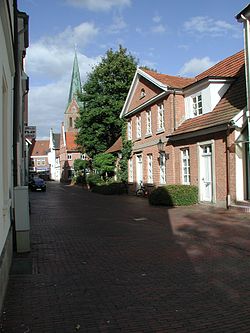University of Lingen
| Lingen | ||
|---|---|---|

Old town
|
||
|
||
|
Location of Lingen within Emsland district
|
||
| Coordinates: 52°31′23.016″N 7°19′23.8044″E / 52.52306000°N 7.323279000°ECoordinates: 52°31′23.016″N 7°19′23.8044″E / 52.52306000°N 7.323279000°E | ||
| Country | Germany | |
| State | Lower Saxony | |
| District | Emsland | |
| Government | ||
| • Mayor | Dieter Krone | |
| Area | ||
| • Total | 176.15 km2 (68.01 sq mi) | |
| Elevation | 24 m (79 ft) | |
| Population (2015-12-31) | ||
| • Total | 53,284 | |
| • Density | 300/km2 (780/sq mi) | |
| Time zone | CET/CEST (UTC+1/+2) | |
| Vehicle registration | EL | |
| Website | lingen.de | |
Lingen is a town in Lower Saxony, Germany. In 2008 the population was 52,353, and in addition there are about 5,000 people who have registered the city as their secondary residence. Lingen, specifically "Lingen (Ems)" is located on the river Ems in the southern part of the Emsland district, which borders North Rhine-Westphalia in the south and the Netherlands in the west. Lingen was first mentioned in the Middle Ages (975 AD).
Lingen is known for its offshore- and nuclear industry (Emsland Nuclear Power Plant), but also for its beautiful nature alongside the river Ems. The University of Applied Sciences Osnabrueck has set up a branch campus, located in the centre of Lingen, with the three Institutes for Management and Engineering, Communications Management and Teaching of Theatre. In 2000 the institutes in Lingen merged into the Faculty of Society and Technology. In 2010 there are expected to be about 2000 students attending.
Lingen has five twin cities:
...
Wikipedia




